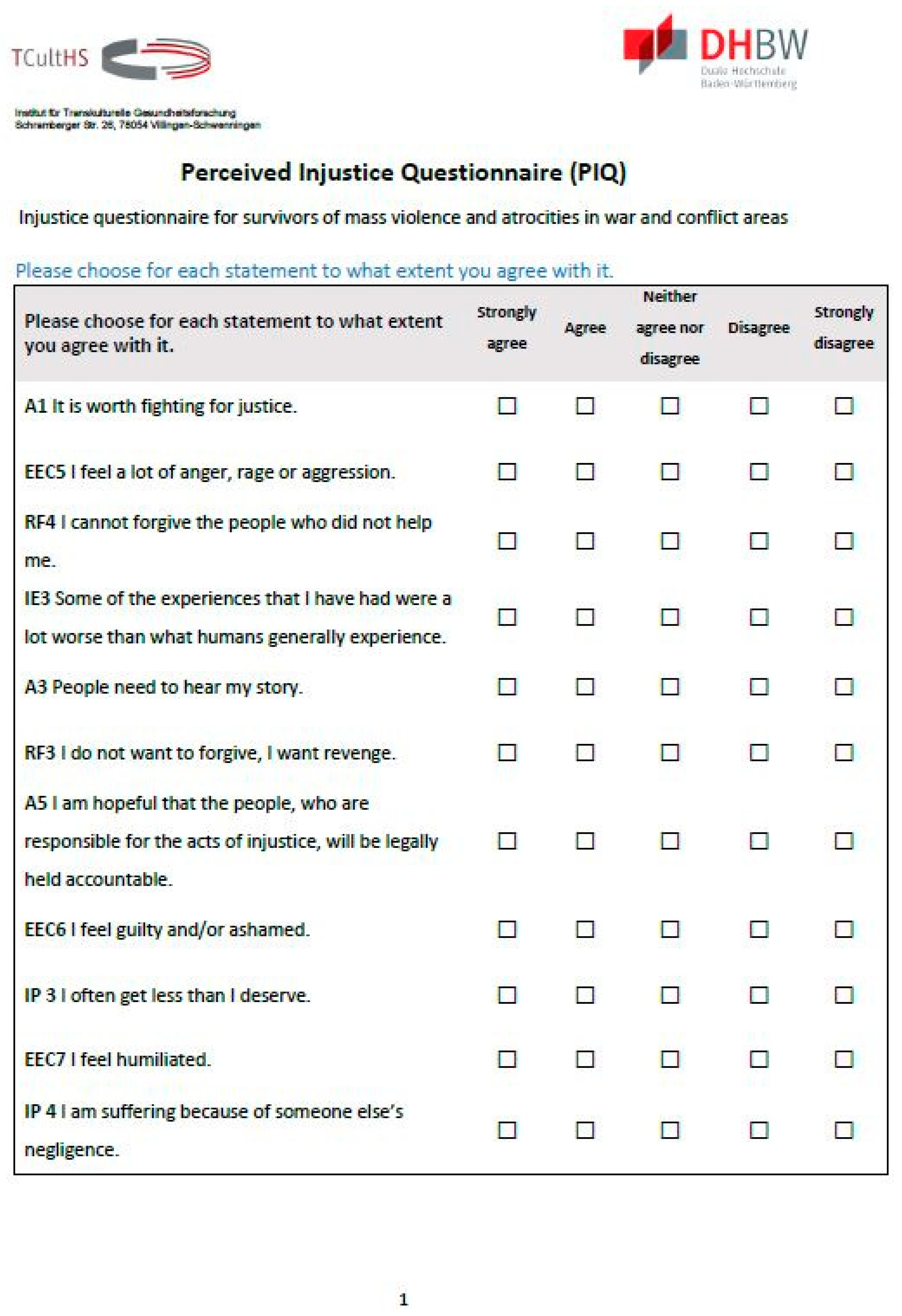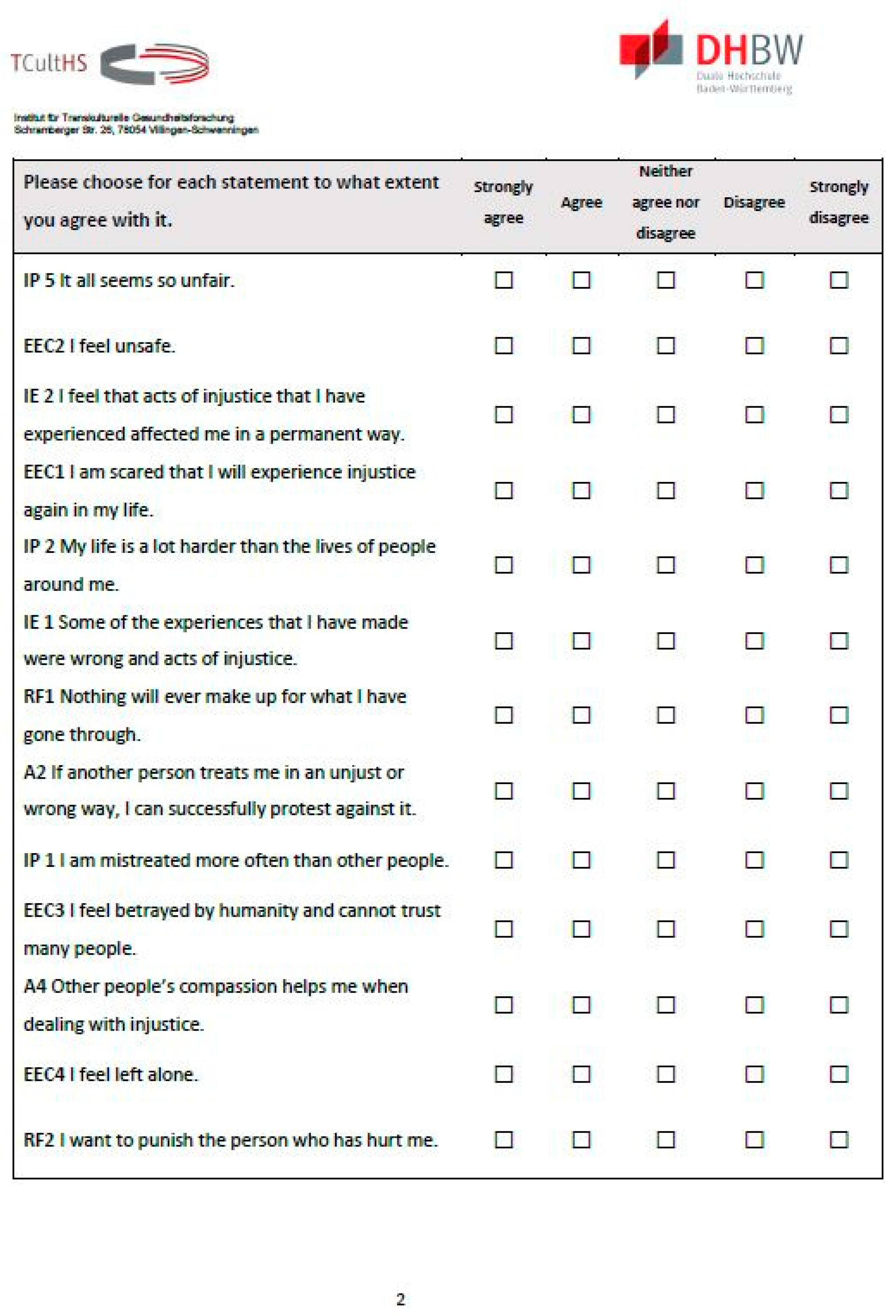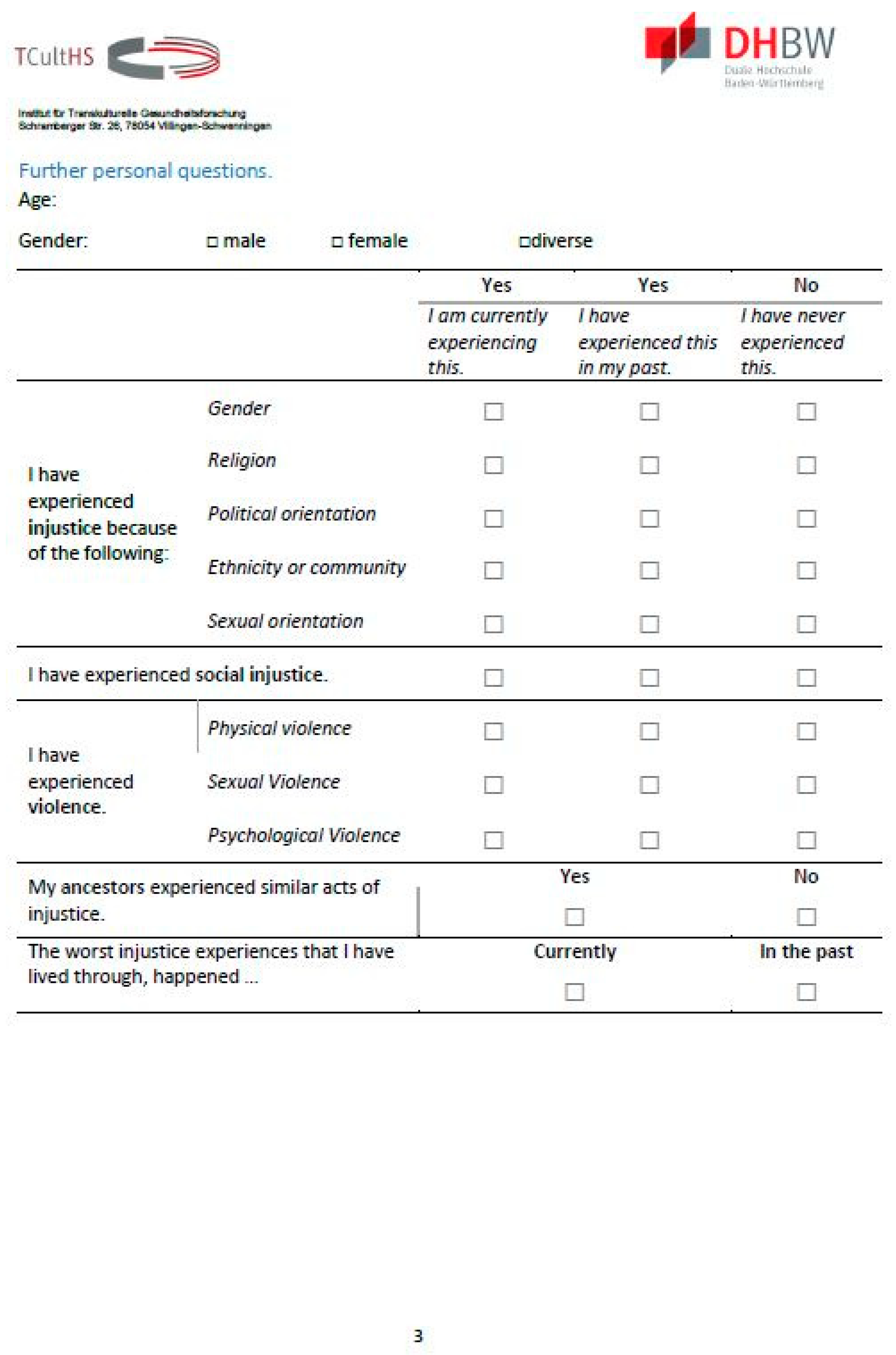Development of a Questionnaire to Measure the Perceived Injustice of People Who Have Experienced Violence in War and Conflict Areas: Perceived Injustice Questionnaire (PIQ)
Abstract
:1. Introduction
2. Methods
2.1. Development of the PIQ
2.2. Study Population
2.3. Methods of Analysis
3. Results
3.1. Principal Component Analysis
3.2. Reliability
3.3. Between-Group Differences (Mann–Whitney U Tests)
3.4. Description of the PIQ
4. Discussion
Limitations
5. Conclusions
Author Contributions
Funding
Institutional Review Board Statement
Informed Consent Statement
Data Availability Statement
Conflicts of Interest
Appendix A
Appendix A.1. Detailed Information about Focus Groups and Original Interviews
Appendix A.1.1. Methods
- Focus groups and interviews. The survey with the questions for the face-to-face interviews were distributed to many different psychosocial institutions in Germany and through some international organizations around the world. Yet, the responses were little.
- Audio recording was possible only in one interview (14). In all focus groups, there was at least one person who did not wish to be recorded after being asked for permission.
- The institutions provided the interpreters. In two groups (1 + 4) they were non-sworn and came to Germany as refugees as well. In group 2, the attending psychotherapist and the social worker interpreted.
- The group discussions lasted between 45 to 70 min
Appendix A.1.2. Overview of the Results
Appendix B. The PIQ



Appendix C. Scoring of the PIQ
- Score (ECC) ≥ 3.5
- Score (IP) ≥ 3.5
- Score (IE) ≥ 3.7
- Score (RF) ≥ 3.7
References
- Fetchenhauer, D.; Huang, X. Justice sensitivity and distributive decisions in experimental games. Pers. Individ. Differ. 2004, 36, 1015–1029. [Google Scholar] [CrossRef]
- Sullivan, M.J.L.; Adams, H.; Horan, S.; Maher, D.; Boland, D.; Gross, R. The Role of Perceived Injustice in the Experience of Chronic Pain and Disability: Scale Development and Validation. J. Occup. Rehabil. 2008, 18, 249–261. [Google Scholar] [CrossRef] [PubMed] [Green Version]
- Trost, Z.; Scott, W.; Buelow, M.T.; Nowlin, L.; Turan, B.; Boals, A.; Monden, K.R. The association between injustice perception and psychological outcomes in an inpatient spinal cord injury sample: The mediating effects of anger. Spinal Cord 2017, 55, 898–905. [Google Scholar] [CrossRef] [PubMed] [Green Version]
- Sullivan, M.J.L. Perceptions of Injustice and Problematic Pain Outcomes. Pain Med. 2020, 21, 1315–1336. [Google Scholar] [CrossRef] [PubMed]
- Carriere, J.S.; Pimentel, S.D.; Yakobov, E.; Edwards, R.R. A Systematic Review of the Association Between Perceived Injustice and Pain-Related Outcomes in Individuals with Musculoskeletal Pain. Pain Med. 2020, 21, 1449–1463. [Google Scholar] [CrossRef]
- Kizilhan, J.I.; Friedl, N.; Neumann, J.; Traub, L. Potential trauma events and the psychological consequences for Yazidi women after ISIS captivity. BMC Psychiatry 2020, 20, 1–8. [Google Scholar] [CrossRef]
- Fazel, M.; Wheeler, J.; Danesh, J. Prevalence of serious mental disorder in 7000 refugees resettled in western countries: A systematic review. Lancet 2005, 365, 1309–1314. [Google Scholar] [CrossRef]
- Cohen, M.H.; Fabri, M.; Cai, X.; Shi, Q.; Hoover, D.R.; Binagwaho, A.; Culhane, M.A.; Mukanyonga, H.; Karegeya, D.K.; Anastos, K. Prevalence and Predictors of Posttraumatic Stress Disorder and Depression in HIV-Infected and At-Risk Rwandan Women. J. Women’s Health 2009, 18, 1783–1791. [Google Scholar] [CrossRef] [Green Version]
- Loncar, M.; Medved, V.; Jovanović, N.; Hotujac, L. Psychological consequences of rape on women in 1991-1995 war in Croatia and Bosnia and Herzegovina. Croat. Med. J. 2006, 47, 67–75. [Google Scholar]
- Kizilhan, J.I. Impact of sexual violation of ISIS terror against Yazidi women after five years. JSM Sex Med. 2020, 4, 1025. [Google Scholar]
- Terr, L.C. Childhood traumas: An outline and overview. Am. J. Psychiatry 1991, 148, 10–20. [Google Scholar] [CrossRef] [PubMed]
- Pham, P.N.; Weinstein, H.M.; Longman, T. Trauma and PTSD Symptoms in Rwanda: Implications for attitudes toward justice and reconciliation. JAMA 2004, 292, 602–612. [Google Scholar] [CrossRef] [PubMed] [Green Version]
- Tay, A.K.; Rees, S.J.; Tam, N.; Savio, E.; Da Costa, Z.M.; Silove, D. The Role of Trauma-Related Injustice in Pathways to Posttraumatic Stress Symptoms Among Conjugal Couples: A Multilevel, Dyadic Analysis in Postconflict Timor-Leste. SAGE Open 2017, 7, 215824401772368. [Google Scholar] [CrossRef] [Green Version]
- Başoğlu, M.; Livanou, M.; Crnobarić, C.; Frančišković, T.; Suljić, E.; Đurić, D.; Vranešić, M. Psychiatric and Cognitive Effects of War in Former Yugoslavia: Association of lack of redress for trauma and posttraumatic stress reactions. JAMA 2005, 294, 580–590. [Google Scholar] [CrossRef] [Green Version]
- Dalbert, C.; Montada, L.; Schmitt, M. Glaube an eine gerechte Welt als Motiv: Validierungskorrelate zweier Skalen. Psychol. Beiträge 1987, 29, 596–615. [Google Scholar]
- Znoj, H. Berner Verbitterungs Inventar; [Bernese Embitterment Inventory] Hans Huber, Hogrefe AG: Bern, Switzerland, 2008. [Google Scholar]
- Schmitt, M.; Baumert, A.; Gollwitzer, M.; Maes, J. The Justice Sensitivity Inventory: Factorial Validity, Location in the Personality Facet Space, Demographic Pattern, and Normative Data. Soc. Justice Res. 2010, 23, 211–238. [Google Scholar] [CrossRef]
- Linden, M.; Schippan, B.; Baumann, K.; Spielberg, R. Die posttraumatische Verbitterungsstörung (PTED). Der Nervenarzt 2004, 75, 51–57. [Google Scholar] [CrossRef]
- Kizilhan, J.I.; Neumann, J. The Significance of Justice in the Psychotherapeutic Treatment of Traumatized People after War and Crises. Front. Psychiatry 2020, 11, 540. [Google Scholar] [CrossRef]
- Lerner, M.J. Evaluation of performance as a function of performer’s reward and attractiveness. J. Pers. Soc. Psychol. 1965, 1, 355–360. [Google Scholar] [CrossRef]
- Lerner, M.J. The Belief in a Just World: A Fundamental Delusion; Plenum Press: New York, NY, USA, 1980; ISBN 9781489904485. [Google Scholar]
- Grove, L.C. Managing Just World Beliefies in an Unjust World for Victims of Sexual Violence. Ph.D. Thesis, University of Montana, Missoula, MT, USA, 2019; p. 11446. [Google Scholar]
- Wenzel, T.; Griengl, H.; Stompe, T.; Mirzaei, S.; Kieffer, W. Psychological Disorders in Survivors of Torture: Exhaustion, Impairment and Depression. Psychopathology 2000, 33, 292–296. [Google Scholar] [CrossRef]
- Neumann, J. Die Wahrnehmung von Ungerechtigkeit bei geflüchteten Personen. The perception of injustice in refugees. In Traumaarbeit mit Geflüchteten—Transkulturelle Aspekte Trauma Work with Refugees—Transcultural Aspects; Kizilhan, J.I., Ed.; Asanger: Kröning, Germany, 2020; pp. 22–33. [Google Scholar]
- Kizilhan, J.I.; Noll-Hussong, M. Individual, collective, and transgenerational traumatization in the Yazidi. BMC Med. 2017, 15, 1–4. [Google Scholar] [CrossRef] [PubMed] [Green Version]
- Cronbach, L.J. Coefficient alpha and the internal structure of tests. Psychometrika 1951, 16, 297–334. [Google Scholar] [CrossRef] [Green Version]
- Kaiser, H.F. An index of factorial simplicity. Psychometrika 1974, 39, 31–36. [Google Scholar] [CrossRef]
- Tabachnick, B.G.; Fidell, L.S. Using Multivariate Statistics, 6th ed.; Pearson Education Inc.: Boston, MA, USA, 2013. [Google Scholar]
- Guttman, L. Some necessary conditions for common-factor analysis. Psychometrika 1954, 19, 149–161. [Google Scholar] [CrossRef]
- Fisseni, H.J. Lehrbuch der Psychologischen Diagnostik (2. Überarb. und Erw. Aufl.); Textbook of Psychological Diagnostics; Hogrefe: Göttingen, Germany, 1997. [Google Scholar]
- Lynch, J.; Fox, S.; D’Alton, P.; Gaynor, K. A Systematic Review and Meta-Analysis of the Association between Perceived Injustice and Depression. J. Pain 2021, 22, 643–654. [Google Scholar] [CrossRef]
- Gregory, R.J. Psycological Testing: History, Principal and Aplications; Pearson/Allyn and Bacon: Boston, MA, USA, 2007. [Google Scholar]
- Schmidt-Atzert, L.; Amelang, M.; Fydrich, T. Psychologische Diagnostik: Mit 82 Tabellen, 5. [Psychological Diagnostics], Vollständig Überarbeitete und Erweiterte Auflage; Springer: Berlin, Germany, 2012; ISBN 9783642170003. [Google Scholar]
- Baghdadi, A.-S.I. National Reconcilliation in Iraq: National Reconciliation an Analytical Approach from a Sociopolitical PerSpective. Democracy and Civil Activism Appendix. Al-Sabah Newspaper, 26 August 2008. [Google Scholar]
| Factor 1 | Factor 2 | Factor 3 | Factor 4 | rit | |
|---|---|---|---|---|---|
| Emotional and cognitive consequences (ECC) | |||||
| Item ECC 1 | 0.775 | 0.343 | 0.740 | ||
| Item ECC 2 | 0.836 | 0.306 | 0.712 | ||
| Item ECC 3 | 0.846 | 0.744 | |||
| Item ECC 4 | 0.731 | 0.740 | |||
| Item ECC 5 | 0.523 | 0.503 | 0.633 | ||
| Item ECC 6 | 0.685 | 0.336 | 0.607 | ||
| Injustice perception (IP) | |||||
| Item IP 1 | 0.664 | 0.331 | 0.770 | ||
| Item IP 2 | 0.779 | 0.341 | 0.808 | ||
| Item IP 3 | 0.796 | 0.705 | |||
| Item IP 4 | 0.531 | 0.688 | 0.666 | ||
| Item IP 5 | 0.761 | 0.381 | 0.789 | ||
| Injustice experience (IE) | |||||
| Item IE 1 | 0.668 | 0.525 | |||
| Item IE 2 | 0.651 | 0.560 | |||
| Item IE 3 | 0.596 | 0.381 | 0.350 | 0.529 | |
| Revenge and forgiveness (RF) | |||||
| Item RF 1 | 0.699 | 0.346 | 0.324 | 0.487 | |
| Item RF 2 | 0.317 | 0.654 | 0.649 | ||
| Item RF 3 | 0.762 | 0.659 | |||
| Item RF 4 | 0.669 | 0.668 | |||
| Variance explained | 25.338% | 17.564% | 13.710% | 13.167% |
| Total Sample (N = 89) | Amount of Items | Mean | Standard Deviation | Cronbachs Alpha |
|---|---|---|---|---|
| Injustice Experience (IE) | 3 | 3.56 | 0.67 | 0.710 |
| Injustice Perception (IP) | 5 | 3.02 | 0.79 | 0.895 |
| Emotional and cognitive consequences (ECC) | 6 | 2.95 | 0.79 | 0.883 |
| Revenge and Forgiveness (RF) | 4 | 3.32 | 0.78 | 0.800 |
| n | M | SD | Z | U | p | r c | |||
|---|---|---|---|---|---|---|---|---|---|
| Emotional and cognitive consequences (ECC) | Violence experience | No | 25 | 2.42 | 0.51 | −4.37 | 77 | <0.001 *** | 0.63 |
| Yes a | 23 | 3.46 | 0.64 | ||||||
| Total | 48 | 2.92 | 0.78 | ||||||
| Injustice experience | No | 29 | 2.64 | 0.80 | −2.77 | 505 | 0.006 ** | 0.30 | |
| Yes b | 55 | 3.11 | 0.74 | ||||||
| Total | 84 | 2.95 | 0.79 | ||||||
| Injustice perception (IP) | Violence experience | No | 26 | 3.11 | 0.40 | −4.19 | 105.5 | <0.001 *** | 0.59 |
| Yes | 25 | 3.66 | 0.50 | ||||||
| Total | 51 | 3.38 | 0.53 | ||||||
| Injustice experience | No | 22 | 2.58 | 0.62 | −3.56 | 260 | 0.001 *** | 0.42 | |
| Yes | 50 | 3.22 | 0.78 | ||||||
| Total | 72 | 3.02 | 0.79 | ||||||
| Injustice experience (IE) | Violence experience | No | 26 | 3.27 | 0.49 | −4.51 | 91 | <0.001 *** | 0.63 |
| Yes | 25 | 4.04 | 0.49 | ||||||
| Total | 51 | 3.65 | 0.62 | ||||||
| Injustice experience | No | 29 | 2.87 | 0.44 | −6.91 | 92.5 | <0.001 *** | 0.73 | |
| Yes | 60 | 3.89 | 0.49 | ||||||
| Total | 89 | 3.56 | 0.67 | ||||||
| Revenge and forgiveness (RF) | Violence experience | No | 24 | 3.17 | 0.34 | −4.95 | 52.5 | <0.001 *** | 0.71 |
| Yes | 24 | 4.02 | 0.48 | ||||||
| Total | 48 | 3.59 | 0.60 | ||||||
| Injustice experience | No | 28 | 2.86 | 0.43 | −4.78 | 265 | <0.001 *** | 0.53 | |
| Yes | 53 | 3.57 | 0.81 | ||||||
| Total | 81 | 3.32 | 0.78 |
| n | M | SD | Z | U | p | r a | |||
|---|---|---|---|---|---|---|---|---|---|
| Item A1: “It is worth fighting for justice.” | Violence experience | No | 26 | 4.35 | 0.63 | −1.33 | 251.50 | 0.185 | - |
| Yes | 24 | 4 | 0.93 | ||||||
| Total | 50 | 4.18 | 0.80 | ||||||
| Injustice experience | No | 29 | 3.79 | 0.94 | −1.08 | 715.5 | 0.810 | - | |
| Yes | 57 | 3.93 | 1.12 | ||||||
| Total | 86 | 3.88 | 1.06 | ||||||
| Item A2: “If another person treats me in an unjust or wrong way, I can successfully protest against it.” | Violence experience | No | 26 | 3.58 | 0.50 | −2.32 | 210 | 0.210 | - |
| Yes | 24 | 3.25 | 0.44 | ||||||
| Total | 50 | 3.42 | 0.50 | ||||||
| Injustice experience | No | 29 | 3.62 | 0.73 | −1.37 | 688 | 0.170 | - | |
| Yes | 57 | 3.42 | 0.78 | ||||||
| Total | 88 | 3.49 | 0.76 | ||||||
| Item A3: “People need to hear my story.” | Violence experience | No | 26 | 2.92 | 0.69 | −3.98 | 120 | ≤0.001 *** | 0.56 |
| Yes | 24 | 3.83 | 0.70 | ||||||
| Total | 50 | 3.36 | 0.83 | ||||||
| Injustice experience | No | 29 | 2.59 | 0.95 | −4.10 | 396 | ≤0.001 *** | 0.44 | |
| Yes | 57 | 3.51 | 0.95 | ||||||
| Total | 86 | 3.2 | 1.04 | ||||||
| Item A4: “Other people’s compassion helps me when dealing with injustice”. | Violence experience | No | 26 | 4.15 | 0.09 | −2.89 | 185 | 0.004 ** | 0.41 |
| Yes | 24 | 4.58 | 0.10 | ||||||
| Total | 50 | 4.36 | 0.07 | ||||||
| Injustice experience | No | 29 | 3.41 | 0.18 | −3.24 | 499.50 | 0.001 *** | 0.35 | |
| Yes | 57 | 4.09 | 0.12 | ||||||
| Total | 86 | 3.86 | 0.11 | ||||||
| Item A5: “I am hopeful that the people who are responsible for the acts of injustice will be legally held accountable.” | Violence experience | No | 26 | 4.04 | 0.92 | −8.08 | 273 | 0.419 | - |
| Yes | 24 | 3.83 | 0.82 | ||||||
| Total | 50 | 3.94 | 0.87 | ||||||
| Injustice experience | No | 28 | 3.11 | 1.26 | −1.28 | 667.50 | 0.202 | - | |
| Yes | 57 | 3.42 | 1.09 | ||||||
| Total | 85 | 3.32 | 0.12 |
Publisher’s Note: MDPI stays neutral with regard to jurisdictional claims in published maps and institutional affiliations. |
© 2021 by the authors. Licensee MDPI, Basel, Switzerland. This article is an open access article distributed under the terms and conditions of the Creative Commons Attribution (CC BY) license (https://creativecommons.org/licenses/by/4.0/).
Share and Cite
Neumann, J.C.; Berger, T.; Kizilhan, J.I. Development of a Questionnaire to Measure the Perceived Injustice of People Who Have Experienced Violence in War and Conflict Areas: Perceived Injustice Questionnaire (PIQ). Int. J. Environ. Res. Public Health 2021, 18, 12357. https://doi.org/10.3390/ijerph182312357
Neumann JC, Berger T, Kizilhan JI. Development of a Questionnaire to Measure the Perceived Injustice of People Who Have Experienced Violence in War and Conflict Areas: Perceived Injustice Questionnaire (PIQ). International Journal of Environmental Research and Public Health. 2021; 18(23):12357. https://doi.org/10.3390/ijerph182312357
Chicago/Turabian StyleNeumann, Johanna Christina, Thomas Berger, and Jan Ilhan Kizilhan. 2021. "Development of a Questionnaire to Measure the Perceived Injustice of People Who Have Experienced Violence in War and Conflict Areas: Perceived Injustice Questionnaire (PIQ)" International Journal of Environmental Research and Public Health 18, no. 23: 12357. https://doi.org/10.3390/ijerph182312357
APA StyleNeumann, J. C., Berger, T., & Kizilhan, J. I. (2021). Development of a Questionnaire to Measure the Perceived Injustice of People Who Have Experienced Violence in War and Conflict Areas: Perceived Injustice Questionnaire (PIQ). International Journal of Environmental Research and Public Health, 18(23), 12357. https://doi.org/10.3390/ijerph182312357






